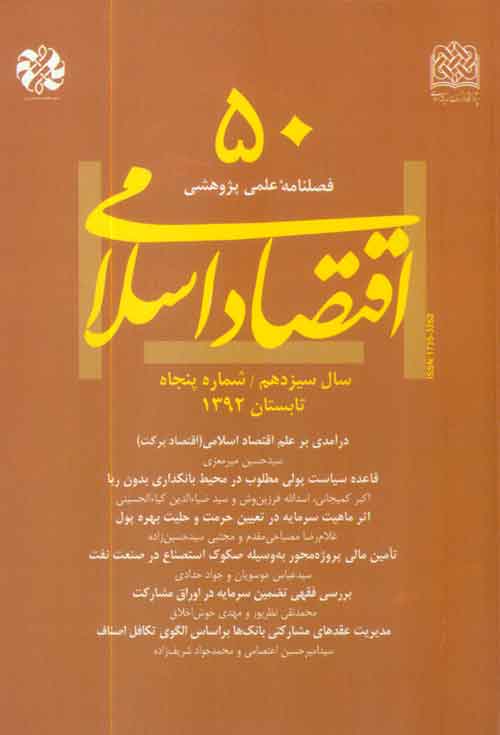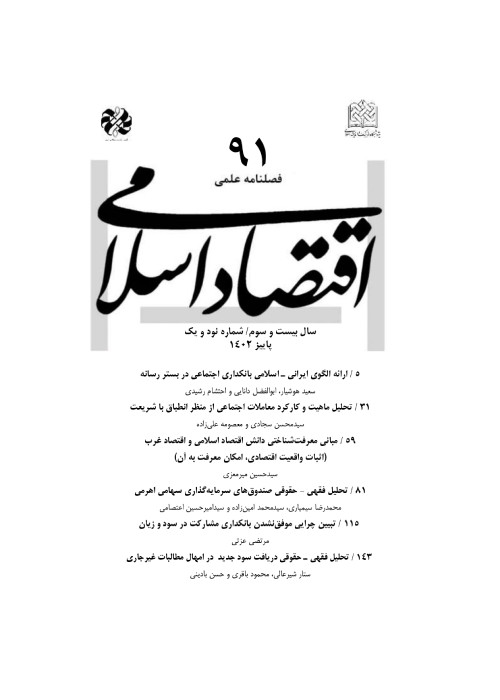فهرست مطالب

فصلنامه اقتصاد اسلامی
پیاپی 50 (تابستان 1392)
- 180 صفحه، بهای روی جلد: 60,000ريال
- تاریخ انتشار: 1392/05/22
- تعداد عناوین: 6
-
-
Page 5This paper is aimed at suggesting that Islamic economics be founded in the new framework of "Baraka economics". Baraka Economics is a science that deals with discovering the causes of and impediments to the sustainable growth of the material gifts necessary for humane society's prosperity on the basis of the ontological, epistemological and value foundations of Islam, and accordingly describes and analyses the societies and supplies strategies for the sustainable growth of material gifts. Gifts are whatever things useful for the prosperity of human beings that lead to their tranquility, convenience and pleasure in their this-worldly and other-worldly lives. Abundant and sustainable gift is calledBaraka. The causes of and impediments to the growth of gifts are people's deeds of hearts and limbs. The functions of this science are as follows: 1. describing the conditions of the society under scrutiny regarding benefiting from gifts, 2. explaining the described situation by stating its causes, 3. anticipating about the society's future situation regarding the extent of benefiting from gifts, and 4. suggesting solutions for the society's reaching the increasing and sustainable growth of gifts. The rules of this science can be stated as if "A", then "B". In this conditional theorem, the antecedent, that is "A", is a deed of heart like faith or of limbs like piety of the individuals or the society, and the consequent, that is "B", states increasing or decreasing of gifts. This science's rules are inferred from Quran's verses and the Rawayahs with the aid of reason. Moreover, one must use the indexing method for applying these rules on different societies and for reaching the aims of describing, explaining,
-
Page 31Choosing inappropriate monetary policies in the past decades and the appearance of new economic problems led to paying attention to the issue of optimization in choosing the desirable monetary policy and to such concepts as the cost of inflation reduction, time inconsistency, Nash equilibrium, and the credibility and reputation of the central bank. The optimization process results in policy rules and reaction functions, which the central banks are required officially to announce and follow in order to achieve their objective functions. This study aims at answering the question whether, considering the interestconstraint in the Iranian banking system, it is possible to identify an optimal policy rule as a guide for the long-term pathway of monetary policy. To this end, it addresses two well-known monetary policy rules, that is Taylor rule and McCallum rule, the former being based on the stock money rate and the latter on the rate of monetary base, and tries to investigate their compatibility with the interest free banking system. It also tries to examine the hypothesis that these two monetary-policy rules, in being concentrated on the money stock rate and the rate of monetary base, apply to the interest-free banking. The study shows that considering the efficiency of these two rules in empirical works inconnection with some developing countries, with some flexibility they can also function as suitable rules for the long term monetary policies.Keywords: Monetary Policy, Interest, Free Banking, Monetary Policy Rules, Taylor Monetary Policy Rule, McCallum Monetary Policy Rule
-
Page 59In the studies already done regarding interest, two criteria have been discussed for diagnosing its being prohibited or approbated. These two criteria concern the nature of interest and the nature of contract. They suggest that the predetermined interest - whether fixed or variable - in terms of loan contracts is the true prohibited Riba. In this article, we will show that although these two criteria are necessary for diagnosing theprohibition or approbation of interest, they are not sufficient and an additional criterion - which is related to the nature of capital - is needed. However, since most conflicts about interest is associated with financial capital and money, in this paper we focus on financial capital. Therefore, there are two kinds of benefit to this type of capital: actual benefit and potential benefit. Our study suggests that receiving and paying interest is permitted only in two cases: when interest is essentially not predetermined; and when interest is predetermined, but firstly it is not in terms of loan contract and secondly the benefit of the traded capital is actual.Keywords: Interest, Usury, Financial capital, Actual value, Fiat value, Actual benefit, Potential benefit
-
Page 79Project-based management is an approach in which the project properties are regarded as the financing support and the received loans are repaid using the future gains. Project-based management can be fulfilled through issuing Sukuk. This system is an approach that exercises the potentials of this kind of financing in the form of Islamic financial instruments. Given the justifiability of fulfilling the upstream oil projects and the significant cash flows resulting from them, one can expect that it may be possible to exercise the methods suggested here in the Iranian oil industry. This research, which has been fulfilled using a qualitative approach and an interpretative research method based on expert's views and focusing on case studies, is directed towards introducing and exercising project-based financing using the capacities of Istisna Sukuk. In conclusion, a model for project-based financing through Istisna Sukuk is introduced that has been reached by some modifications in the general models of Istisna Sukuk enforced with the aim of the model being more consistent with the limitations of oil projects.Keywords: financing, project, based, Sukuk, Istisna, upstream oil sector
-
Page 111With regard to the prohibition of Riba (Interest) in Islam and consequently the prohibition of using interest-based instruments, using them will be impossible. The Islamic economics researchers, therefore, have been looking for appropriate alternatives for them. In this respect, Musharakah Sukuk which are based on the legitimate bond of Sharakah were designed and used, and today constitute a great portion of liquidity in Iran. However, the risks present in the economic activities have caused the capital owners, especially those risk-averse ones, to look for some sort of guarantee for theprincipal. Due to the importance and application of the capital guaranteeing provisionin Musharakah bonds, this paper attempts to examine the jurisprudential arguments related with capital guaranteeing. We will use the descriptiveanalytical research method, library resources and the traditional method of Hawzah. Our hypothesis is that the Capital Guaranteed Bonds are not excluded by the standards of Islam. This hypothesis is confirmed by our research results.Keywords: Musharakah Sukuk, Sharakah bond, Capital guaranteeing
-
Page 131Many experts believe that the participatory contract is one of the most frequently used Islamic bonds in the field of Islamic banking and some even regard its existence as a sign of Islamic mood in banking. There are some requirements for exercising participatory bonds in accordance with Islamic Shariah, which the current banking system doesnt observe. In this research, after analyzing the trend of this kind of bonds in the Iranianbanking system, we scrutinize, using a descriptive-analytical method, the challenges and requirements of participatory bonds. We explain, then, the shortcomings and advantages of the banking system and introduce a model for properly exercising this kind of contracts in the framework of usury-free banking system. In the suggested solution, the commercial banks proceed with indirectly allocating their participatory resources via the guilds for products and services. The union as the institution of and in charge of "Takaful", by founding an investment fund and using some percentages of the loans in the profitable plans, covers the possible damages of the guild units and contributes to theprofit-making and dynamism of the guilds, as well. In conclusion, we examine the requirements, advantages and challenges of this method.Keywords: participatory bonds, guild's Takaful, risk management, usury, free banking


